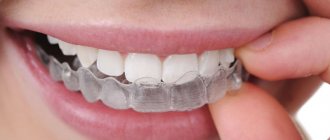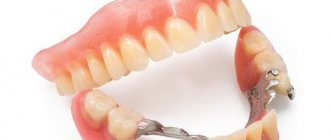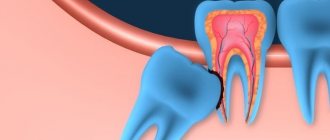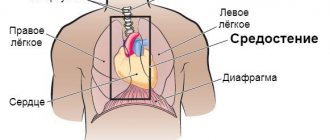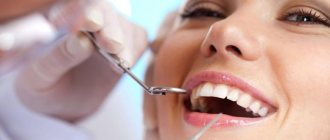A tooth on an artificial root has a multicomponent structure. The supporting part in the form of a cylindrical or conical rod sits tightly in the jaw bone. An abutment imitating a tooth stump is fixed on top of the root substitute. And the prosthesis is already attached to it. Normally, all elements of the system are fixedly connected to each other, so if the crown on the implant is loose, it needs to be sorted out. There may be several reasons for this phenomenon, which is the task of the dentist to establish.
Main causes of loosening
Most often, an unstable position is due to rejection. This can happen due to the doctor’s lack of qualifications and his failure during the operation. During preparation, the root substitute itself (its size and shape) may be incorrectly selected, the cleanliness of the teeth may be impaired, when preparing the bed for installation, overheating of the tissues in this area may occur, and the structure may be installed in the wrong position.
Another option is to use low-quality products. Often, small private clinics purchase dental products from resellers in order to save money. Large dental organizations purchase only from time-tested manufacturers, this guarantees protection against counterfeit products.
The orthodontist is not always to blame for implant rejection; sometimes the reason for this is insufficient hygiene. Neglect of a doctor's recommendations can have very serious consequences. The most significant mistakes: taking medications without the consent of a doctor, heavy chewing load, hypothermia or exposure to too high temperatures, for example, when visiting a sauna.
What symptoms should you consult a doctor for?
Risks can be identified during the recovery period after surgery. This:
- Pain that only gets worse, but 10 or more days have passed since the operation.
- Swelling that does not go away after 7 days.
- The bleeding does not stop a day or two after the intervention.
- There is pus and a strange smell.
- The temperature stays above 38o.
But it happens that dental implants (usually titanium) were installed relatively long ago, and the healing process is behind them. There seem to be no tangible problems, but the structure becomes unstable. During the examination, fistula tracts, perforations, and other problems may be detected.
Human diseases and complications
Another reason for rejection may be the patient’s silence about existing health problems. Diseases that can negatively affect the outcome of treatment include diabetes mellitus, dysfunction of the thyroid gland and immune system, problems of the central nervous system, existing tumors, chemotherapy, allergic reactions to drugs used for implantation, injuries and bruises, and much more.
To avoid consequences in the future, experts strongly recommend carrying out preventive examinations at least once a year, and also do not forget about undergoing a general medical examination.
Complications with the mobility of implants include: partial or complete loss of the artificial root and crown, the development of a complex inflammatory process not only in the mouth, but throughout the body, destruction of bone tissue and, as a consequence, the impossibility of another installation without a procedure for augmenting the missing tissue.
Why do installed dental implants loosen?
Usually the cause of loosening is rejection. The problem occurs due to:
Mistakes made by the implantologist during the operation:
- incorrectly selected rod model, the dimensions of which do not correspond to the anatomy of the jaw;
- overheating of the tissue during preparation of the implant bed;
- violation of sterility conditions;
- incorrect location of the structure in the jawbone;
- insufficient study of the patient's medical history.
Implantation of a low-quality or counterfeit dental system , which is also considered a medical error. Large clinics purchase dental structures directly from the manufacturer. This eliminates the risk of installing a fake. Small dentists usually purchase systems through resellers.
Failure of the patient to comply with the doctor’s recommendations:
- self-prescribing and taking medications;
- ignoring medications prescribed by a doctor;
- overheating or hypothermia during the rehabilitation period (visiting saunas, diving into an ice hole);
- lack of oral hygiene;
- excessive load on the implant immediately after its installation;
- not visiting a dentist to monitor the healing process;
- hiding existing health problems from the doctor.
Deterioration of the patient's health :
- getting injured;
- development or exacerbation of cardiovascular diseases, tuberculosis;
- development of diseases that negatively affect immunity (AIDS, HIV);
- the appearance of malignant tumors.
Implantologist's opinion : “A high-quality implant, provided that all implantation rules are followed, should not wobble, regardless of its service life. If mobility of the structure occurs, it is necessary to remove the titanium rod and repeat the operation. If we talk about the reasons for this complication, the success of implantation directly depends on the fusion of the implant with the bone. When the structure wobbles, it means fusion has not occurred. A movable implant negatively affects neighboring teeth and the alveolar process. Therefore, there is no need to delay your visit to the doctor.”
Rejection of the implantation system always begins with inflammation. The following may appear in its background:
- long lasting pain;
- swelling and redness of the gums;
- prolonged bleeding;
- discharge of pus from the gums;
- bad breath.
If inflammation is not stopped in time, it will spread from the soft tissues to the jaw bone and cause its destruction. Rejection can begin either a few days after installation or after several years of operation of the structure. Also, the reason that the artificial root began to sway is the lack of osseointegration due to a reaction of the body that cannot be foreseen in advance.
The survival rate of implants, even if all conditions are met, is 90-95%. There is always a risk of rejection.
What to do if you get loose
Of course, it is very important to seek advice from your doctor as soon as possible. Only a professional will be able to determine why the pin is moving, conduct a complete sanitation of the oral cavity and prescribe a comprehensive examination. After removal, antibacterial treatment will be carried out, after which it will be possible to talk about the etiology of this pathology. If there is a doctor's error or non-compliance with the rules of care, a repeat operation may be prescribed.
If engraftment fails due to the small volume of bone tissue, then bone augmentation will most likely be required. If chronic disorders or oncology were discovered, then another installation will have to be abandoned. An alternative may be removable prosthetics.
Often, symptoms that appear, for example, the smell of rot or movement, can be eliminated by carrying out the following manipulations: screwing in the pin plug, thoroughly cleaning all external elements. In some cases, the dentist is able to save the implant. The most important recommendation is a timely visit to a medical facility at the slightest suspicion of loosening.
What consequences may there be
Loosening of the implant causes serious complications:
- the titanium rod may completely .
- If the cause of the swing of the dental system is an inflammatory process, then there is a risk of infection spreading to neighboring tissues and even throughout the body, which poses a serious threat to the health and life of the patient.
- If left untreated, inflammation provokes severe bone destruction , which makes it impossible to re-implant an artificial root without bone augmentation.
Mobility of the coronal part
Quite often, patients mistake the unstable position of the crown for loosening of the base. This may occur due to the gradual loosening of the screw that secures the top of the artificial tooth. To fix it, you need to contact your dentist, who can tighten the screw and cover it with a small amount of filling material.
In the case where the connection of the crown part to the abutment was carried out using cement, the crown will have to be temporarily dismantled. After this, the area around is cleared of cement residues and re-installation is carried out.
Unfortunately, it is quite difficult to independently diagnose the problem and the root cause of what happened, which is why it is recommended to go to the hospital as soon as possible. Of course, there are a number of obvious signs by which one can suspect that the process of rejection has begun. This usually includes sharp pain, increased body temperature, soreness, swelling, the appearance of pus, etc.
previous post
What to do if a fragment remains in the socket after tooth extraction?
next entry
Prevention of crown loosening on an implant
It is easier to prevent any pathology than to eliminate it. To maximize the service life of the crown-abutment-implant system, the following preventive rules should be followed:
- Don't neglect oral hygiene. Brush your teeth twice a day, use irrigators to wash out food debris from hard-to-reach places.
- Do not overload artificial teeth by chewing too hard food, do not crack nuts, do not chew crackers.
- Try to give up bad habits.
In addition, you can prevent or detect the problem in time if you visit the dentist every six months to examine the implantation area and check the condition of your own and artificial teeth.
Design features of implants
There are several types of implants that are installed to replace lost teeth. All of them differ from each other in the design features of the structure. These can be single structures without the possibility of removal or with conditional removal.
There are permanent bridge-like structures. And the third type is removable structures of various types: single or group. And each implant model mainly consists of two parts.
The first part is called intraosseous; the shape of the part is sharp and cone-shaped. Very rarely, plate-shaped options are installed. Such an element of the implant transmits chewing vibrations to the alveolar processes or directly to the basal part of the jaw.
The second part of the implant is the abutment, which is located between the body of the implant and the crown prosthesis itself. This element is also required in all designs and serves to transmit the chewing movement from the prosthesis to the body of the implant. Depending on the design, an artificial crown is attached to this part in different ways.
How long can you walk with a temporary crown?
Temporary crowns are a quick restoration of the aesthetics and functionality of teeth until permanent dentures are installed. Their service life is the time required to create permanent orthopedic structures, as well as implant healing. When can a permanent prosthesis be installed on an implant? Up to 4 months is the healing period of the implant in the lower jaw, up to 6 months in the upper jaw. After this, permanent dental prosthetics can be performed.
In some cases, for example, after implantation of All-on-4, All-on-6, a temporary prosthesis can last up to two years. During this time, the patient will have time to financially prepare for the installation of a high-quality permanent prosthesis. If the patient uses a temporary crown for a long time, it is necessary to come to the clinic every six months for a preventive examination. When worn for a long time, the following complications may occur:
✔
abrasion of crowns, leading to displacement of adjacent teeth;
✔
inflammation of the gums due to the accumulation of bacteria on plastic;
✔
gum growth and pain due to damage to the crown.
To make a temporary crown on an implant last longer:
- avoid sticky and hard foods;
- brush your teeth gently, without pressing hard on the area where the implant is installed;
- floss as carefully as possible.
What will happen if you do nothing?
A loose implant is prone to worsening its own condition - the negative phenomenon will definitely not go away on its own and will not remain at the same level unless you consult a doctor. At a minimum, the implant can fall out - just like an ordinary tooth. Such a process will definitely not be painless; it is always accompanied by gradual infection and suppuration of the gums, with a further deterioration in the general condition of the body, including an increase in temperature. Negative processes also contribute to the destruction of bone - it can be restored, but this requires time and money, and most importantly, it postpones the re-implantation of a new implant and a return to normal life until the distant future.
What can cause implant mobility?
Implant mobility may be a symptom of peri-implantitis (inflammation) or product rejection. Both complications require an urgent visit to the doctor in order to eliminate the inflammatory process and save the structure. To do this, the dentist eliminates the affected tissue, purulent exudate, and inflammatory process. Treatment includes treatment of the gums, curettage (cleaning) if necessary, and prescription of medications. In the absence of timely treatment, the implant may fall out, infection may spread deep into the jaw, and destruction of bone tissue may occur.
Or maybe it’s not the implant itself that’s loose, but the crown?
If yes, then this is the best news, because in this case you just need to tighten the screw connecting the abutment and the crown. To do this, you also need to go to a specialist, but this is not long and not expensive. It happens that the cement does not hold the crown - then it is removed and the cement layer is replaced, which is also not so scary. The main thing is not to delay these procedures, because bacteria may begin to multiply in the cavity formed in the mouth, and we do not need this at all. In addition, you cannot be sure that the problem is exactly that, in its mildest form. There is an opinion that a loose abutment, unlike a loose crown, almost always provokes severe pain, but it is still better not to engage in self-diagnosis and immediately consult a doctor.
Nature of pain
In the first 3-5 days, pain after the installation of dental systems is a normal reaction of the body to surgical intervention. Analgesics prescribed by a doctor help cope with discomfort. If it hurts under the implant after the first week, after six months, a year or later, you will need the help of a doctor.
To identify the causes of pain, its type plays an important role:
- by nature - pressing, pulsating, dull, cutting;
- according to the degree of localization - within a certain area, diffuse, irradiating;
- according to the presence of additional symptoms - swelling, itching, redness, mobility of the structure.
Why are temporary crowns placed before permanent ones?
It may seem that a temporary crown is an extra material cost and should not be included in the cost of prosthetics.
Let us dwell once again on the need to use temporary crowns and emphasize their main advantages.
- Psychological calm.
Imitating your own teeth allows you to maintain self-confidence without introducing an imbalance in your daily activities (during business negotiations, smiling, talking, etc.). - Safety of soft tissues of the oral cavity
(prevention of inflammation and atrophy). - Preserving the functionality of teeth.
Thanks to the complete chewing process, possible undesirable consequences for the digestive system are eliminated. - No problems with diction.
- Fast adaptation.
Getting used to the future permanent prosthesis is much easier if you wear temporary crowns first. - Economy.
A temporary crown is a quick “reanimation” of teeth at an affordable cost.
Reasons for the mobility of the structure
The mobility of the product indicates the occurrence of complications: peri-implantitis, tissue infection, rejection. The cause of a loose dental implant may be a complication such as peri-implantitis, more about which you can read at the link. Mobility occurs due to the patient’s fault when the doctor’s recommendations are not followed, information about diseases of the body is concealed, or the rehabilitation period is violated. Complications may occur due to the doctor’s fault in the following cases:
- Insufficient examination of the patient's body.
- Incorrect design.
- Use of unsuitable or poor quality parts.
- Violation of asepsis rules.
- Incorrect installation of implants.
- Overheating of the jaw bone tissue.
- Lack of sanitation of the oral cavity before treatment.
Reviews
We wish all patients who have undergone implantation not to encounter such a problem as the unsteadiness of the crown or prosthesis.
But, if you nevertheless suffered such a sad fate, tell us what caused the mobility of the crown and how you dealt with it. You can do this by leaving a comment at the bottom of the page.
If you find an error, please select a piece of text and press Ctrl+Enter.
Tags dental crowns fixed dentures
Did you like the article? stay tuned
Previous article
Unique Sia braces – the orthodontic art of Italy
Next article
Empress inlays - reliable dental restoration while maintaining functionality
